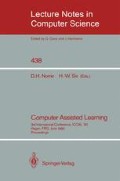Abstract
In summary, it is apparent that a computer-based sound analysis system will provide information which, in association with analysis of a performer's audiovisual records can permit identification of performance behaviour. This facility makes possible the structuring of a database of tagged performance attributes that, when recognized by a computer-driven interactive instructional system, will allow a CAL environment to provide a musician with both diagnostic response to performance or instructional feedback for skill acquisition, depending on how the system is programmed when the computer recognizes what the acoustic musical performer is doing. For the purposes of securing greater reliability and validity in the computer-based analysis of performance behaviour, the process described here must be replicated many times and the frequency spectra analyzed quantitatively across the range and types of performance responses. However, within the limits of this study it is worthwhile noting that, gradually, both the technology of computer-based sound processing and its potential for education are evolving toward the generation of practical tools for music learning.
Preview
Unable to display preview. Download preview PDF.
Bibliography
Clendinning, J. (1983). Computer recognition of pitch for musical applications. Unpublished masters thesis, North Texas State University.
Czvitkovicz, G. A. (1984). A real-time pitch extractor. Unpublished masters thesis, University of Illinois at Urbana-Champaign.
Dubnowski, J., Schafer, R., & Rabiner, L. R. (1976). Real-time digital hardware pitch detector. Institute of Electrical and Electronics Engineers Transactions on Acoustics, Speech, and Signal Processing, 24 (February) 2–8.
Kolb, R. (1984). A real-time microcomputer-assisted system for translating aural, monophonic tones into music notation as an aid in sightsinging. Unpublished doctoral dissertation, The Louisiana State University and Agricultural and Technical College, Ph.D.
Rees, F. J. (1988, August). The development of a computer-driven, interactive program for teaching vibrato to beginning violinists. Paper presented at the meeting of the International Council for Distance Education, Oslo, Norway.
Rees, F. J. (1986). The incorporation of remediation procedures for an individualized interactive videodisc-based program for learning vibrato technique on the violin. In Stevens, R. S. (Ed.), Computer Technology and Music Education: The Australian Beginning. Victoria, Australia: Deakin University.
Rees, F. J. (1985–6). A PLATO-based videodisc self-instructional program for directing the development of string vibrato technique. Journal of Educational Technology Systems, 14 (4), 283–296.
Terhardt, E., Stoll, G., & Seewann M. (1982). Pitch of complex signals according to virtual-pitch theory: Tests, examples, and predictions. Journal of the Acoustical Society of America, 71 (3), 671–678.
Author information
Authors and Affiliations
Editor information
Rights and permissions
Copyright information
© 1990 Springer-Verlag Berlin Heidelberg
About this paper
Cite this paper
Rees, F.J., Michelis, R.M. (1990). The description of a process for identifying musical performance behavior in instrumentalists using computer-based sound spectrum analysis, with implications for an interactive acoustic musical system. In: Norrie, D.H., Six, HW. (eds) Computer Assisted Learning. ICCAL 1990. Lecture Notes in Computer Science, vol 438. Springer, Berlin, Heidelberg. https://doi.org/10.1007/BFb0020899
Download citation
DOI: https://doi.org/10.1007/BFb0020899
Published:
Publisher Name: Springer, Berlin, Heidelberg
Print ISBN: 978-3-540-52699-5
Online ISBN: 978-3-540-47111-0
eBook Packages: Springer Book Archive

